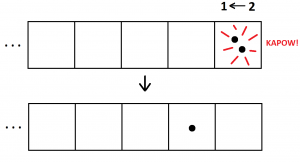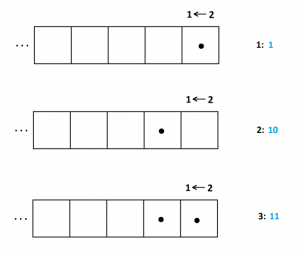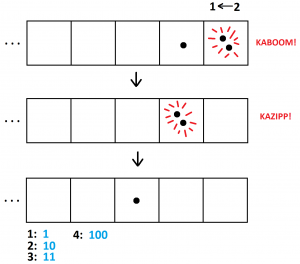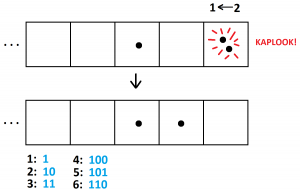Exploding Dots
1.2 The \(1 \leftarrow 2\) Machine
Lesson materials located below the video overview.
See how Goldfish & Robin and friends, “When Young Minds Collide,” demonstrate workings of this machine too: Kids Explain Math For Kids and Mâquinas de 1<–2 (Spanish).
Okay. Here is the story that is not true.
When I was a child I invented a machine – not true – and this machine is nothing more than a row of boxes that extends as far to the left as I could ever desire.
I gave this machine of mine a name. I called it a “two-one machine” both written and read in a funny backward way. (I knew no different as a child.)

And what do you do with this machine? You put in dots. Dots always go into the rightmost box.
Put in one dot, and, well, nothing happens: it stays there as one dot. Ho hum!

But put in a second dot – always in the rightmost box – and then something exciting happens.
Whenever there are two dots in a box they explode and disappear – KAPOW! – to be replaced by one dot, one box to the left.

(Do you see now why I called this a “ machine” written in this funny way?)
We see that two dots placed into the machine yields one dot followed by zero dots.
Putting in a third dot – always the rightmost box – gives the picture one dot followed by one dot.

I realized that this machine, in my untrue story, was giving codes for numbers.
Just one dot placed into in the machine, stayed as one dot. Let’s say that that the \(1\leftarrow2\) machine code for the number one is \(1\).
Two dots placed into the machine, one after the other, yielded one dot in a box followed by zero dots. Let’s say that the \(1\leftarrow2\) machine code for the number two is \(10\).
Putting a third dot in the machine gives the code \(11\) for three.

What’s the \(1\leftarrow2\) machine code for four?
Putting a fourth dot into the machine is particularly exciting: we are in for multiple explosions!

The \(1\leftarrow2\) code for four is \(100\).
What will be the code for five? Can you see it’s \(101\)?
And the code for six? Adding one more dot to the code for five gives \(110\) for six.

Actually, we can also get this code for six by clearing the machine to then put in six dots all at once. Pairs of dots will explode in turn to each produce one dot, one box to their left.
Here is one possible series of explosions. Sound effects omitted!

Do you get the same final code of \(110\) if you perform explosions in a different order? (Try it!)
PRACTICE QUESTIONS
Here are some questions you might or might not want to try. My solutions to them appear in the final section of this experience.
1 a) What is the \(1\leftarrow2\) machine code for the number thirteen? (It turns out to be \(1101\). Can you get that answer?)
b) What is the code for fifty in this machine? (Whoa!)
2 Could a number ever have code \(100211\) in a \(1\leftarrow2\) machine, assuming we always choose to explode dots if we can?
3 Which number has code \(10011\) in a \(1\leftarrow2\) machine?
There are hours of fun to be had playing with codes in a \(1\leftarrow2\) machine.
But then one day, I had an astounding flash of insight!
SPANISH VERSION (COMING!)
See how Goldfish & Robin and friends, “When Young Minds Collide,” demonstrate workings of this machine too: Kids Explain Math For Kids and Mâquinas de 1<–2 (Spanish).
Okay. Here is the story that is not true.
When I was a child I invented a machine – not true – and this machine is nothing more than a row of boxes that extends as far to the left as I could ever desire.
I gave this machine of mine a name. I called it a “two-one machine” both written and read in a funny backward way. (I knew no different as a child.)

And what do you do with this machine? You put in dots. Dots always go into the rightmost box.
Put in one dot, and, well, nothing happens: it stays there as one dot. Ho hum!

But put in a second dot – always in the rightmost box – and then something exciting happens.
Whenever there are two dots in a box they explode and disappear – KAPOW! – to be replaced by one dot, one box to the left.

(Do you see now why I called this a “ machine” written in this funny way?)
We see that two dots placed into the machine yields one dot followed by zero dots.
Putting in a third dot – always the rightmost box – gives the picture one dot followed by one dot.

I realized that this machine, in my untrue story, was giving codes for numbers.
Just one dot placed into in the machine, stayed as one dot. Let’s say that that the \(1\leftarrow2\) machine code for the number one is \(1\).
Two dots placed into the machine, one after the other, yielded one dot in a box followed by zero dots. Let’s say that the \(1\leftarrow2\) machine code for the number two is \(10\).
Putting a third dot in the machine gives the code \(11\) for three.

What’s the \(1\leftarrow2\) machine code for four?
Putting a fourth dot into the machine is particularly exciting: we are in for multiple explosions!

The \(1\leftarrow2\) code for four is \(100\).
What will be the code for five? Can you see it’s \(101\)?
And the code for six? Adding one more dot to the code for five gives \(110\) for six.

Actually, we can also get this code for six by clearing the machine to then put in six dots all at once. Pairs of dots will explode in turn to each produce one dot, one box to their left.
Here is one possible series of explosions. Sound effects omitted!

Do you get the same final code of \(110\) if you perform explosions in a different order? (Try it!)
PRACTICE QUESTIONS
Here are some questions you might or might not want to try. My solutions to them appear in the final section of this experience.
1 a) What is the \(1\leftarrow2\) machine code for the number thirteen? (It turns out to be \(1101\). Can you get that answer?)
b) What is the code for fifty in this machine? (Whoa!)
2 Could a number ever have code \(100211\) in a \(1\leftarrow2\) machine, assuming we always choose to explode dots if we can?
3 Which number has code \(10011\) in a \(1\leftarrow2\) machine?
There are hours of fun to be had playing with codes in a \(1\leftarrow2\) machine.
But then one day, I had an astounding flash of insight!
SWAHILI VERSION (COMING!)
See how Goldfish & Robin and friends, “When Young Minds Collide,” demonstrate workings of this machine too: Kids Explain Math For Kids and Mâquinas de 1<–2 (Spanish).
Okay. Here is the story that is not true.
When I was a child I invented a machine – not true – and this machine is nothing more than a row of boxes that extends as far to the left as I could ever desire.
I gave this machine of mine a name. I called it a “two-one machine” both written and read in a funny backward way. (I knew no different as a child.)

And what do you do with this machine? You put in dots. Dots always go into the rightmost box.
Put in one dot, and, well, nothing happens: it stays there as one dot. Ho hum!

But put in a second dot – always in the rightmost box – and then something exciting happens.
Whenever there are two dots in a box they explode and disappear – KAPOW! – to be replaced by one dot, one box to the left.

(Do you see now why I called this a “ machine” written in this funny way?)
We see that two dots placed into the machine yields one dot followed by zero dots.
Putting in a third dot – always the rightmost box – gives the picture one dot followed by one dot.

I realized that this machine, in my untrue story, was giving codes for numbers.
Just one dot placed into in the machine, stayed as one dot. Let’s say that that the \(1\leftarrow2\) machine code for the number one is \(1\).
Two dots placed into the machine, one after the other, yielded one dot in a box followed by zero dots. Let’s say that the \(1\leftarrow2\) machine code for the number two is \(10\).
Putting a third dot in the machine gives the code \(11\) for three.

What’s the \(1\leftarrow2\) machine code for four?
Putting a fourth dot into the machine is particularly exciting: we are in for multiple explosions!

The \(1\leftarrow2\) code for four is \(100\).
What will be the code for five? Can you see it’s \(101\)?
And the code for six? Adding one more dot to the code for five gives \(110\) for six.

Actually, we can also get this code for six by clearing the machine to then put in six dots all at once. Pairs of dots will explode in turn to each produce one dot, one box to their left.
Here is one possible series of explosions. Sound effects omitted!

Do you get the same final code of \(110\) if you perform explosions in a different order? (Try it!)
PRACTICE QUESTIONS
Here are some questions you might or might not want to try. My solutions to them appear in the final section of this experience.
1 a) What is the \(1\leftarrow2\) machine code for the number thirteen? (It turns out to be \(1101\). Can you get that answer?)
b) What is the code for fifty in this machine? (Whoa!)
2 Could a number ever have code \(100211\) in a \(1\leftarrow2\) machine, assuming we always choose to explode dots if we can?
3 Which number has code \(10011\) in a \(1\leftarrow2\) machine?
There are hours of fun to be had playing with codes in a \(1\leftarrow2\) machine.
But then one day, I had an astounding flash of insight!
Resources
Books
Take your understanding to the next level with easy to understand books by James Tanton.
BROWSE BOOKS![]()
Guides & Solutions
Dive deeper into key topics through detailed, easy to follow guides and solution sets.
BROWSE GUIDES![]()
Donations
Consider supporting G'Day Math! with a donation, of any amount.
Your support is so much appreciated and enables the continued creation of great course content. Thanks!
Ready to Help?
Donations can be made via PayPal and major credit cards. A PayPal account is not required. Many thanks!
DONATE![]()


